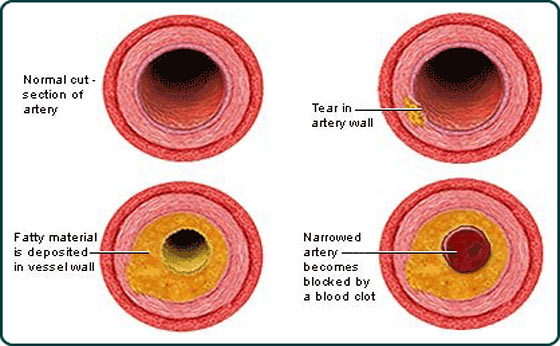Survive Longer By Lowering Your Cholesterol With These Foods

Cholesterol is a waxy, fat-like substance found in your body and in many foods. Your body needs cholesterol to function normally and makes all that you need.
However you can end up with too much cholesterol because of the foods you eat and the rate at which your body breaks down cholesterol.
Excess cholesterol can build up in your arteries. After a while, the deposits narrow your arteries, putting you at risk for heart disease and stroke.
Preparedness is not always about the end of the world. The ‘here and now’ of high cholesterol levels can affect your long-term survivability.
Here are several foods that you can eat to help lower ‘bad’ LDL cholesterol levels:
Oats – Oatmeal – Bran
Studies have shown that oats and bran can significantly lower LDL blood cholesterol levels.
Consider eating a bowl of oatmeal every day. Oatmeal contains soluble fiber, which reduces the amount of cholesterol put into your bloodstream.
Oat bran in particular has been proven to reduce cholesterol levels and can be added to cereals or homemade breads.
Garlic
Apparently half a clove of raw garlic a day can significantly reduce LDL cholesterol levels.
It can easily be added to salads, or tossed in with your favorite stir fry.
Flax Seeds
Not only does this food provide you with cholesterol lowering capabilities, but it also provides many other important nutrients, such as omega 3.
Flax seeds can be easily added to your cereal in the morning, or topped on salad as an oil.
Olive Oil
Olive oil contains a powerful mix of antioxidants to lower your cholesterol.
Replace butter, lard or mayonnaise with olive oil.
Olive oil is high in calories so go easy on the amount.
Almonds – Walnuts
A handful of nuts – about an ounce and a half – each day of walnuts and/or almonds will help keep blood vessels healthy.
Be careful though, as nuts are high in calories and could lead to weight gain.
Fish
The American Heart Association recommends you eat at least two servings of fatty fish per week.
Fatty fish contain omega-3 fatty acids, known to improve heart health.
These fish contain the most omega-3 fatty acids:
Albacore tuna, Halibut, Herring, Lake trout, Mackerel, Salmon, Sardines
Fruits
Apples, grapes, strawberries and citrus fruits contain pectin, a soluble fiber known to lower cholesterol levels.
Avoid Foods That Raise Cholesterol
It makes sense, but the best way to lower cholesterol is to not eat foods that raise cholesterol levels.
Watch out for saturated fat – the white “marbling” in meat when it’s cold. Choose extra lean meats rather than fatty meats.
Drink low fat or skim milk instead of regular varieties.
Use olive oil instead of butter.
Not everyone is affected the same way by eating foods that may raise cholesterol levels, but if you’re one of those with high LDL cholesterol (the ‘bad’ cholesterol), common sense indicates that it may be prudent to research which foods may be making it worse and which foods may be better to eat instead.
Low-density lipoproteins (LDL)
Make up the majority of the body’s cholesterol. It’s called “bad cholesterol” because high levels can lead to heart disease and stroke.
High-density lipoproteins (HDL)
Called “good cholesterol” because high levels reduce the risk for heart disease and stroke. Scientists think that HDL absorbs bad cholesterol and carries it to the liver, which then flushes it from the body.
Triglycerides
Triglycerides are not cholesterol, but are a different type of fat. High levels can raise the risk for heart disease. Triglycerides are often part of a blood test doctors do to check cholesterol levels.
Desirable Cholesterol Levels
according to the CDC
Total cholesterol Less than 200 mg/dL
LDL (“bad” cholesterol) Less than 100 mg/dL
HDL (“good” cholesterol) 40 mg/DL or higher
Triglycerides Less than 150 mg/dL
